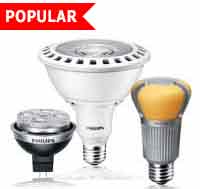Say Goodbye to Old-Fashioned Light Bulbs
Old-fashioned incandescent light bulbs are on their way to becoming obsolete. The first to go is the 100-watt, which is no longer being produced as of January. The next to go will be the 75-watt bulb in January 2013, followed by 60- and 40-watt bulbs in 2014.
The phase-out is a result of the Energy Independence and Security Act (EISA) of 2007, which was intended to make better use of resources and to help the U.S. become energy independent. Part of the law sets energy efficiency standards for lightbulbs. The law requires that by 2020 most light bulbs be 60 to 70 percent more efficient than standard incandescent bulbs, according to the U.S. Environmental Protection Agency.
ComEd encourages consumers to illuminate their homes with energy-efficient light bulbs, such as compact fluorescent lamps (CFLs). These lights consume about 75 percent less energy and last about 10 times longer than traditional incandescent bulbs, lower electricity costs and decrease the amount of greenhouse gas emissions in the environment, according to a ComEd press release.
ComEd customers can learn more about energy-efficient lighting options, such as CFLs and LED bulbs, by visiting the “home savings” section of the ComEd.com home page, which also includes information on how to obtain discounts for select ENERGY STAR®-qualified lighting products. ComEd lighting experts also offer customers tips during visits to home improvement stores across northern Illinois.
ComEd lighting experts will be at the following retail stores this month:
- April 21, 10 a.m. to 2 p.m., Lowe's, 1000 Willow Rd., Northbrook
- April 21, 10 a.m. to 2 p.m. Menards, 6301 Oakton St., Morton Grove
Consumers should also know that the Federal Trade Commission (FTC) now requires new fact labels on light bulb packaging to educate them about lighting products and help them choose the best energy-efficient light bulb for their needs. The labels include energy costs per year, indicate the bulb’s life expectancy, and provide information on wattage and “lumens,” the unit measurement of a light bulb’s brightness.
Those planning to discard of their old incandescent bulbs should be aware that they are not allowed in the recycling bin.
Old incandescent bulbs should be disposed of in the garbage, said Cameron Ruen, marketing coordinator for the Solid Waste Agency of Northern Cook County.
“You won’t find a recycling option for incandescent bulbs. Incandescent bulbs are safe to go in the garbage,” Ruen said.
Pat Dieckhoff, McHenry County College waste reduction assistant, advises that incandescent light bulbs be properly wrapped for disposal. “Bundle it up well so it’s not an issue with the person putting it into the truck,” she said.
While incandescent light bulbs can’t be recycled, they can be reused by the crafty. Green Eco Services shows some ways to reuse bulbs including turning them into little, hanging flower vases.
Source: Skokie Patch

















Comments